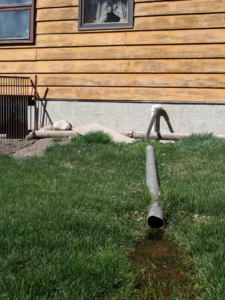Sump Pumps: Why Does My Home Need One, And How Do I Test It?

A sump pump can be one of the most important pieces of equipment for foundation drainage systems, but there’s a good chance you’ve never considered how well it’s working to protect your home. Why would your home need a sump pump, and how can you test how well it’s working?
What Is A Sump Pump?
 A sump pump sits at the lowest point of your house and will pump out any water that accumulates around or below the foundation. You’ll usually find it in the basement, with the foundation built in ways that direct water towards it. The pump also uses centrifugal force to create a low-pressure environment to suck water in and force it out through a pipe that dumps it away from your home.
A sump pump sits at the lowest point of your house and will pump out any water that accumulates around or below the foundation. You’ll usually find it in the basement, with the foundation built in ways that direct water towards it. The pump also uses centrifugal force to create a low-pressure environment to suck water in and force it out through a pipe that dumps it away from your home.
Sump pumps kick in when the water level gets to a certain height; some activate using a pressure sensor, others will trigger using a flotation activator. However it works, most models have a check valve that stops water from trickling back through the outlet pipe, keeping the water funnelled away from the pump.
Why Do I Need A Sump Pump?
Sump pumps are necessary parts of a drain system, whether or not your house is prone to high water levels. While alleviating water accumulation, sump pumps also protect against sewage backups and lower the humidity levels in your basement; if left untreated, the problems can cause damage due to mould or excess dampness.
Even if you live in an area without flooding dangers, there’s always a chance your home could see excessive moisture levels around and under the foundation. If you don’t have a system ready to handle high levels of snowmelt or rain, you could see flooding and a lot of damage to your basement.
Of course, if flooding is an issue where you are, your home will absolutely need a sump pump– and you’ll need to make sure it’s in working order. Here’s how!
How Do I Test My Sump Pump?
 Start by locating the exit pipe, where the water drains out from the pump; it should be clear of any dirt, debris, and anything that could obstruct the flow. The pipe should also direct the water away from the home’s foundation.
Start by locating the exit pipe, where the water drains out from the pump; it should be clear of any dirt, debris, and anything that could obstruct the flow. The pipe should also direct the water away from the home’s foundation.
Next, examine the electrical cords that keep the sump pump running. Many sump pumps have cords that plug into the back of a plug that powers the float. Test it by unplugging both cables, then plugging only the pump cord into the outlet. If you hear a humming sound when turning on the pump, the pump works. Plug the two back in as you found them (usually with the float cord first and the pump cord into the back of the float plug).
If your sump pump only has one cord, pour 20 litres of water into the pit slowly, letting the float rise. When it gets to a certain point, the pump should kick on, pumping the water out. Once the water has removed all the water, the pump should turn itself off.
If the testing of your sump pump shows that it doesn’t work, have a professional come and look at it immediately. Sump pumps should be checked twice a year, before the spring and fall seasons. If your home doesn’t have a sump pump at all, ask Ashworth Drainage for help!
